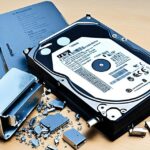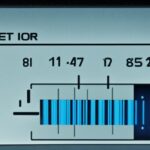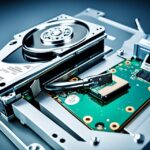Table of Contents
In this digital era, it’s often necessary to remove an OS from a HDD. This might be to make room for a new OS or to clear space. Knowing how to delete an OS improves how well your HDD works.
When you delete an OS, you free up a lot of space on the disk. This not only makes more room but also helps your HDD work better, setting it up for new tasks. There are guides that help you do this without losing your personal data1.
Key Takeaways
- Recognising the need to delete an OS helps with HDD optimisation.
- Clearing space on your HDD can boost its performance.
- Keeping your data safe is important. Always back up your files first.
- There are different ways to remove OS, each useful in its own way.
- After deleting, taking steps to optimise your HDD for future use is helpful.
Understanding the Need to Delete an OS from an HDD
Thinking about removing an operating system from a hard disk? This can bring several benefits of deleting OS. It can boost your system’s performance and make your computing experience better. Also, it helps in managing your hard disk space well. When old system files take up too much space, managing disk space becomes crucial.
The Benefits of Deleting an Operating System
One big advantage is getting back important disk space. This action makes your computer clean, fast, and more efficient. Also, removing the OS can speed up your system. This is because it gets rid of unnecessary files that slow down the computer. Many users enjoy a simpler interface too, as old installation clutter disappears. This leads to a more efficient and enjoyable computer use.
Common Reasons for Removal
The reasons for OS removal can be different for everyone. Some want to upgrade to a newer system, while others are fixing errors or issues. Switching to a different operating system is another reason people delete their old one. This is especially true for those who want to try out new software environments. Sometimes, people just need to clean out secondary disks for future use or to simplify things.
It’s also important to know that just deleting files doesn’t completely remove them. If not done correctly, data can still be recovered. So, for those planning to sell or throw away their devices, it’s crucial to delete data securely. By following steps on how to fully wipe a hard drive, you guard your personal data. This makes sure your device is ready for its next owner. Learn more about secure data wiping here.
| Reason for OS Removal | Description | ||
|---|---|---|---|
| Upgrade | Shifting to a newer system for better features and security. | ||
| Error Resolution | Removing the OS can solve ongoing software problems or crashes. | New Environment | Moving to a different OS based on personal preference or for trials. |
| Disk Cleanup | Emptying secondary disks that are no longer needed for efficiency. |
Knowing about deletion brings the duty of doing it safely. As you get ready to handle your hard disks, knowing the right ways to securely delete data is key. By understanding the benefits of removing an operating system and the reasons behind it, you can confidently go ahead with the task23.
Preparing for the Deletion Process
Starting on the journey to remove an operating system needs careful planning. The first thing to do is to save all important files somewhere safe. This prevents them from being lost by accident. A study has shown that almost half the users think deleting files means they’re gone for good. But, those files can often be retrieved4. To avoid this, it’s crucial to protect your data properly.
Backing Up Your Data
Different methods exist for backing up your data, so you can pick what suits you best. You might choose:
- External hard drives for keeping files locally
- Cloud storage services for access from anywhere with security
- Network-attached storage for sharing with others
Making backups often is key to keeping your data safe when deleting your OS5. This way, even if your hard drive is cleared, your important files are safe. Also, 62% of Windows OS users like using special tools to make their erased data irrecoverable before getting rid of their devices4.
Creating a Recovery Plan
Having a recovery plan ready is crucial for any problems during or after the deletion. Your plan should include:
- Choosing the right data recovery software like EaseUS Data Recovery Wizard
- Knowing how to securely delete data from SSDs and HDDs
- Taking steps after deletion to ensure all data is truly gone
To fully erase data, you might need advanced methods or specific software5. Thus, your recovery plan must outline clear steps to follow if you lose data. This highlights the need for a solid plan for both protecting and recovering data.
How to Delete an OS from an HDD
When it’s time to delete an OS using disk management, many methods can help. Each method aims to make the process easy while keeping your data safe. Let’s talk about three ways to do this effectively.
Using the Disk Management Tool
The Disk Management tool makes it easy to remove an OS from your HDD. Just a few steps, and you can delete the old OS’s partition. This tool shows all partitions clearly, helping you see which ones to take out.
Manual Deletion of Windows Folders
If you prefer being hands-on, manually deleting the OS is an option. This means going into the HDD to find and erase Windows files. It’s important to protect your personal files, so backing them up first is a good plan.
Removing Boot Entries
Once the OS is gone, getting rid of boot entry removal is next. This keeps your boot menu tidy. Use the msconfig command and go to the Boot tab. Here, you can delete the boot entry of the old OS, avoiding future boot problems.
| Method | Description | Advantages |
|---|---|---|
| Disk Management Tool | A graphical tool allowing partition selection for deletion. | Simplifies the deletion process with visual aids. |
| Manual OS Deletion | Directly removing specific Windows folders from the OS directory. | Offers control over what gets deleted, safeguarding personal data. |
| Boot Entry Removal | Using msconfig to clean up the boot entries in Windows. | Prevents boot errors caused by leftover entries. |
Post-Deletion Steps for Optimising Your HDD
After you’ve deleted the operating system, it’s vital to optimise your HDD for better performance. Running disk cleanup is essential. It removes temporary files and leftovers from the deleted OS. This frees up space on your hard drive, making it work more efficiently in the future.
Running Disk Cleanup
The first step towards optimisation is running disk cleanup. This tool looks for files you don’t need, like temporary and system files. By cleaning these out regularly, your drive stays efficient. This leads to a smoother experience on your computer.
Formatting the Partition
Consider partition formatting too, especially on the part where the OS was. This clears all old files and settings. It’s like making the partition brand new, ready for new uses. Formatting not only cleans but might also improve the drive’s performance. It’s a key step after deleting your OS.
| Process | Description | Benefit |
|---|---|---|
| Run Disk Cleanup | Eliminate temporary and unnecessary files. | Frees up additional space. |
| Partition Formatting | Wipe the drive entirely, resetting configurations. | Readies the HDD for new installations. |
By following these steps, you’ll guarantee your HDD’s top performance. It maximises space and efficiency for later use. Remember, regular maintenance is key. Ignoring it can slow down your system and waste resources7.
Conclusion
Getting rid of an operating system from your HDD needs careful prep and knowing how to delete safely. Make sure you back up your data and have a plan for recovery. Doing this makes managing your HDD easier and helps your system run better. A big chunk, 87%, of folks say it’s smart to back up everything before you start deleting8.
Using the correct tools helps a lot in this task. For example, software like AOMEI Partition Assistant lets you wipe data securely. This makes sure your deletion meets your security needs9. Also, with 78% of people worried about their hard drive data getting out, it’s crucial to take steps to safely remove the OS and boost system performance8.
If you get good at managing your HDD, you’ll be happier with your computer. It also means your system will work better. If you’re interested in learning how to build a PC or pick the right parts, check out this helpful article.
FAQ
Why should I delete an operating system from my hard disk drive?
Removing an OS frees up disk space and boosts your system’s performance. It gets rid of files you don’t need anymore.
What are the common reasons for removing an OS?
People usually remove an OS to upgrade to a new one. They also do it to fix errors, switch systems, or clean a secondary drive that’s not in use.
How can I ensure my important files are safe before deleting an OS?
Always back up your files on external drives or online storage. Using data recovery tools as a backup plan helps too. This way, you won’t lose your important data.
What methods are available for deleting an operating system from my HDD?
To delete an OS, you can use Windows Disk Management to erase partitions. You can also delete Windows folders by hand. Another way is to use the msconfig command to clean boot entries.
What should I do after I have deleted my operating system?
Once you’ve deleted the OS, run Disk Cleanup to get rid of temporary files. You might also want to format the partition to prep it for new installations.
Source Links
- https://www.easeus.com/questions/recovery/delete-os-from-hard-drive-but-keep-data.html – How to Delete the OS from a Hard Drive but Keep the Data
- https://askubuntu.com/questions/1248299/how-do-i-uninstall-reinstall-ubuntu-on-hdd-from-separate-os-windows-10-operatin – How do I uninstall/reinstall Ubuntu on HDD from separate OS (Windows 10 operating on SSD)?
- https://www.crucial.com/articles/pc-builders/how-to-wipe-a-hard-drive – How to Securely Wipe a Hard Drive – Windows 8.1 & 10
- https://www.pcmag.com/how-to/how-to-wipe-your-hard-drive – How to Wipe Your Hard Drive
- https://www.novacomputersolutions.com/how-to-permanently-delete-data-from-your-computer/ – How To Permanently Delete Data From Your Computer – NOVA
- https://www.dell.com/support/kbdoc/en-us/000134730/how-do-i-erase-data-from-my-hard-drive – How Do I Erase Data from My Hard Drive
- https://www.avast.com/c-wipe-old-hard-drive – How to Completely Wipe an Old Hard Drive
- https://www.doyourdata.com/erase-data/wipe-everything-but-os.html – How to Wipe Everything Except for the OS from Your Computer?
- https://www.diskpart.com/articles/completely-wipe-a-hard-drive-including-os-1984.html – How to Completely Wipe a Hard Drive Including OS?












